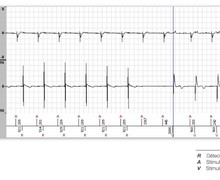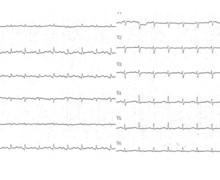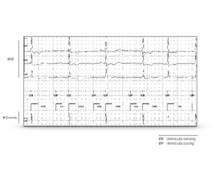Ventricular pause and second MVP version
Tracing
Manufacturer Medtronic
Device PM
Field MVP
N° 12
Patient
72-year-old woman implanted with an Azure XT DR dual-chamber pacemaker for syncopes due to paroxysmal AV block; programming of the MVP mode.

Graph and trace
- atrial sensing and ventricular sensing with prolonged PR interval (AS-VS);
- atrial activation not followed by ventricular sensing;
- premature atrial pacing with an AS-AP interval of 420 ms, followed by ventricular pacing after a short AV delay of 80 ms;
- resumption of 1/1 atrioventricular conduction and absence of switching in DDD mode;
- prolongation of the PR interval followed by identical sequence (premature atrial pacing with an AS-AP interval of 420 ms followed by ventricular pacing after a short AV delay of 80 ms);
- identical sequence (premature atrial pacing with an AS-AP interval of 420 ms, followed by ventricular pacing after a short AV delay of 80 ms);
- identical sequence; 2 out of 4 atrial activities have impaired conduction;
- switching to DDD mode;
- atrial sensing and ventricular pacing for 1 minute;
- assessment of atrioventricular conduction; identical sequence;
- continuation of the DDD mode.
Other articles that may be of interest to you







This tracing illustrates the other major modification incorporated into the new version of the MVP algorithm. After a ventricular extrasystole or blocked atrial activity, an advanced atrial pacing followed by ventricular pacing with short AV delay is delivered to avoid a prolonged ventricular pause. The device does not wait for the occurrence of the ensuing atrial activity (evidence of a P wave or blocked atrial pacing) to diagnose the alteration of atrioventricular conduction.
On the initial version of the algorithm, the maximum ventricular pause following a blocked atrial activity was dependent on the programming of the minimum rate and on the presence of sinus dysfunction (atrial pacing at the minimum rate). For a minimum rate of 60 beats/minute, the maximum pause could reach approximately 2 seconds (4 seconds for a rate of 30 beats/minute). This ventricular pause could potentially generate symptoms but could also favor the occurrence of ventricular arrhythmias (pro-arrhythmogenic effect following a ventricular long interval –short interval sequence). In the new version of the algorithm, 2 out of 4 atrial activities with impaired atrioventricular conduction are always necessary to cause a switch. On the other hand, in order to achieve a more gradual transition to the DDD mode and to avoid the occurrence of possibly symptomatic long-term ventricular pauses, if an atrial activity is not followed by ventricular activation, the device paces the atrium precociously, and then the ventricle with a short AV delay. The device analyzes the successive PR intervals (AP-VS or AS-VS); if atrioventricular conduction is altered (absence of an R wave in a variable window depending on the previous PR intervals), the atrium is paced at least 420 ms, 600 ms at most, after the "blocked" atrial activity (spontaneous or paced). The duration of the AA interval is contingent on the previous measurements of the PR intervals (420 ms if PR normal or <320 ms). Ventricular pacing is subsequently delivered 80 ms after atrial pacing. The aim of this sequence (atrial pacing prior to ventricular pacing) is to avoid the occurrence of a pause while maintaining atrioventricular synchrony to prevent retrograde conduction and thus reduce the risk of pacemaker-mediated tachycardia. The minimal AA delay of 420 ms also avoids pacing in an atrial vulnerable period and avoids induction of atrial arrhythmias. The functioning is similar in case of ventricular extrasystole with also early atrial pacing followed by a ventricular pacing with short AV delay.
Other changes have also been made in the last version of the algorithm. Post-atrial ventricular blanking was reduced from 30 to 10 ms to avoid the risk of undersensing of a late ventricular extrasystole. Once the pacemaker has switched to DDD mode, the search modalities for the return of atrioventricular conduction have been modified so as to avoid iterative searches when atrioventricular conduction only normalizes over a few intervals (re- switching to the DDD mode less than 15 seconds after returning to ADI).
On this new platform of pacemakers, it is possible to obtain the number of switches that have occurred since the last follow-up. The device also provides on the report detailed information on the last 10 commutations with the type of switching, switching dates and times, average ventricular rate, the duration of AV interval. No EGM of the switching episode is recorded.